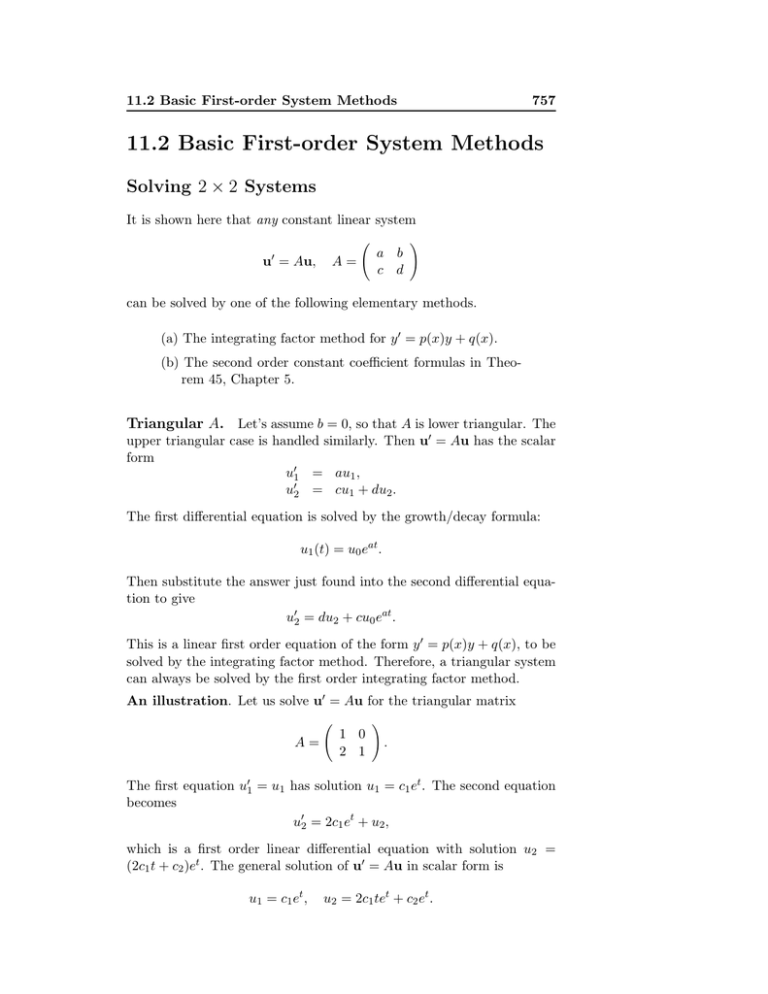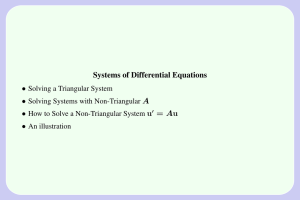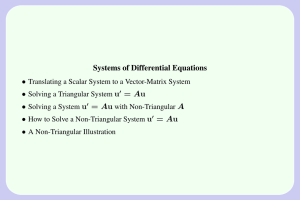11.2 Basic First-order System Methods Solving 2 × 2 Systems
advertisement

11.2 Basic First-order System Methods
757
11.2 Basic First-order System Methods
Solving 2 × 2 Systems
It is shown here that any constant linear system
0
u = Au,
A=
a b
c d
!
can be solved by one of the following elementary methods.
(a) The integrating factor method for y 0 = p(x)y + q(x).
(b) The second order constant coefficient formulas in Theorem 45, Chapter 5.
Triangular A. Let’s assume b = 0, so that A is lower triangular. The
upper triangular case is handled similarly. Then u0 = Au has the scalar
form
u01 = au1 ,
u02 = cu1 + du2 .
The first differential equation is solved by the growth/decay formula:
u1 (t) = u0 eat .
Then substitute the answer just found into the second differential equation to give
u02 = du2 + cu0 eat .
This is a linear first order equation of the form y 0 = p(x)y + q(x), to be
solved by the integrating factor method. Therefore, a triangular system
can always be solved by the first order integrating factor method.
An illustration. Let us solve u0 = Au for the triangular matrix
A=
1 0
2 1
!
.
The first equation u01 = u1 has solution u1 = c1 et . The second equation
becomes
u02 = 2c1 et + u2 ,
which is a first order linear differential equation with solution u2 =
(2c1 t + c2 )et . The general solution of u0 = Au in scalar form is
u1 = c1 et ,
u2 = 2c1 tet + c2 et .
758
The vector form of the general solution is
u(t) = c1
et
2tet
!
0
et
+ c2
!
.
The vector basis is the set
(
B=
et
2tet
!
,
0
et
!)
.
Non-Triangular A. In order that A be non-triangular, both b 6= 0
and c 6= 0 must be satisfied. The scalar form of the system u0 = Au is
u01 = au1 + bu2 ,
u02 = cu1 + du2 .
Theorem 1 (Solving Non-Triangular u0 = Au)
Solutions u1 , u2 of u0 = Au are linear combinations of the list of atoms
obtained from the roots r of the quadratic equation
det(A − rI) = 0.
Proof: The method: differentiate the first equation, then use the equations to
eliminate u2 , u02 . The result is a second order differential equation for u1 . The
same differential equation is satisfied also for u2 . The details:
u001 = au01 + bu02
Differentiate the first equation.
au01
au01
+ bcu1 + bdu2
Use equation u02 = cu1 + du2 .
+ bcu1 + d(u01 − au1 )
Use equation u01 = au1 + bu2 .
=
=
= (a + d)u01 + (bc − ad)u1
Second order equation for u1 found
The characteristic equation of u001 − (a + d)u01 + (ad − bc)u1 = 0 is
r2 − (a + d)r + (bc − ad) = 0.
Finally, we show the expansion of det(A − rI) is the same characteristic polynomial:
a−r
b det(A − rI) = c
d−r = (a − r)(d − r) − bc
= r2 − (a + d)r + ad − bc.
The proof is complete.
The reader can verify that the differential equation for u1 or u2 is exactly
u00 − trace(A)u0 + det(A)u = 0.
Finding u1 . Apply the second order formulas, Theorem 45 in Chapter
5, to solve for u1 . This involves writing a list L of atoms corresponding
11.2 Basic First-order System Methods
759
to the two roots of the characteristic equation r2 − (a + d)r + ad − bc = 0,
followed by expressing u1 as a linear combination of the two atoms.
Finding u2 . Isolate u2 in the first differential equation by division:
1
u2 = (u01 − au1 ).
b
The two formulas for u1 , u2 represent the general solution of the system
u0 = Au, when A is 2 × 2.
An illustration. Let’s solve u0 = Au when
A=
1 2
2 1
!
.
The equation det(A − rI) = 0 is (1 − r)2 − 4 = 0 with roots r = −1 and
r = 3. The atom list is L = {e−t , e3t }. Then the linear combination of
atoms is u1 = c1 e−t + c2 e3t . The first equation u01 = u1 + 2u2 implies
u2 = 21 (u01 − u1 ). The general solution of u0 = Au is then
u1 = c1 e−t + c2 e3t ,
u2 = −c1 e−t + c2 e3t .
In vector form, the general solution is
e−t
−e−t
u = c1
!
+ c2
e3t
e3t
!
.
Triangular Methods
Diagonal n×n matrix A = diag(a1 , . . . , an ). Then the system x0 = Ax
is a set of uncoupled scalar growth/decay equations:
x01 (t) = a1 x1 (t),
x02 (t) = a2 x2 (t),
..
.
x0n (t) = an xn (t).
The solution to the system is given by the formulas
x1 (t) = c1 ea1 t ,
x2 (t) = c2 ea2 t ,
..
.
xn (t) = cn ean t .
The numbers c1 , . . . , cn are arbitrary constants.
760
Triangular n × n matrix A. If a linear system x0 = Ax has a square
triangular matrix A, then the system can be solved by first order scalar
methods. To illustrate the ideas, consider the 3 × 3 linear system
2 0 0
0
x = 3 3 0 x.
4 4 4
The coefficient matrix A is lower triangular. In scalar form, the system
is given by the equations
x01 (t) = 2x1 (t),
x02 (t) = 3x1 (t) + 3x2 (t),
x03 (t) = 4x1 (t) + 4x2 (t) + 4x3 (t).
A recursive method. The system is solved recursively by first order
scalar methods only, starting with the first equation x01 (t) = 2x1 (t). This
growth equation has general solution x1 (t) = c1 e2t . The second equation
then becomes the first order linear equation
x02 (t) = 3x1 (t) + 3x2 (t)
= 3x2 (t) + 3c1 e2t .
The integrating factor method applies to find the general solution x2 (t) =
−3c1 e2t +c2 e3t . The third and last equation becomes the first order linear
equation
x03 (t) = 4x1 (t) + 4x2 (t) + 4x3 (t)
= 4x3 (t) + 4c1 e2t + 4(−3c1 e2t + c2 e3t ).
The integrating factor method is repeated to find the general solution
x3 (t) = 4c1 e2t − 4c2 e3t + c3 e4t .
In summary, the solution to the system is given by the formulas
x1 (t) = c1 e2t ,
x2 (t) = −3c1 e2t + c2 e3t ,
x3 (t) = 4c1 e2t − 4c2 e3t + c3 e4t .
Structure of solutions. A system x0 = Ax for n × n triangular A
has component solutions x1 (t), . . . , xn (t) given as polynomials times
exponentials. The exponential factors ea11 t , . . . , eann t are expressed in
terms of the diagonal elements a11 , . . . , ann of the matrix A. Fewer than
n distinct exponential factors may appear, due to duplicate diagonal
elements. These duplications cause the polynomial factors to appear.
The reader is invited to work out the solution to the system below,
which has duplicate diagonal entries a11 = a22 = a33 = 2.
x01 (t) = 2x1 (t),
x02 (t) = 3x1 (t) + 2x2 (t),
x03 (t) = 4x1 (t) + 4x2 (t) + 2x3 (t).
11.2 Basic First-order System Methods
761
The solution, given below, has polynomial factors t and t2 , appearing
because of the duplicate diagonal entries 2, 2, 2, and only one exponential
factor e2t .
x1 (t) = c1 e2t ,
x2 (t) = 3c1 te2t + c2 e2t ,
x3 (t) = 4c1 te2t + 6c1 t2 e2t + 4c2 te2t + c3 e2t .
Conversion to Systems
Routinely converted to a system of equations of first order are scalar
second order linear differential equations, systems of scalar second order
linear differential equations and scalar linear differential equations of
higher order.
Scalar second order linear equations. Consider an equation
au00 + bu0 + cu = f where a 6= 0, b, c, f are allowed to depend on t,
0 = d/dt. Define the position-velocity substitution
x(t) = u(t),
y(t) = u0 (t).
Then x0 = u0 = y and y 0 = u00 = (−bu0 − cu + f )/a = −(b/a)y − (c/a)x +
f /a. The resulting system is equivalent to the second order equation, in
the sense that the position-velocity substitution equates solutions of one
system to the other:
x0 (t) = y(t),
c(t)
b(t)
f (t)
y 0 (t) = −
x(t) −
y(t) +
.
a(t)
a(t)
a(t)
The case of constant coefficients and f a function of t arises often enough
to isolate the result for further reference.
Theorem 2 (System Equivalent to Second Order Linear)
Let a 6= 0, b, c be constants and f (t) continuous. Then au00 +bu0 +cu = f (t)
is equivalent to the first order system
0
aw (t) =
0
a
−c −b
!
w(t) +
0
f (t)
!
,
w(t) =
u(t)
u0 (t)
!
.
Converting second order systems to first order systems. A similar position-velocity substitution can be carried out on a system of two
second order linear differential equations. Assume
a1 u001 + b1 u01 + c1 u1 = f1 ,
a2 u002 + b2 u02 + c2 u2 = f2 .
762
Then the preceding methods for the scalar case give the equivalence
a1
0
0
0
0
a1
0
0
0
0
a2
0
0
0
0
a2
u1
u01
u2
u02
0
0 a1 0
0
−c −b
0
1
1 0
=
0
0
0 a2
0
0 −c2 −b2
u1
u01
u2
u02
+
0
f1
0
f2
.
Coupled spring-mass systems. Springs connecting undamped coupled masses were considered at the beginning of this chapter, page 746.
Typical equations are
(1)
m1 x001 (t) = −k1 x1 (t) + k2 [x2 (t) − x1 (t)],
m2 x002 (t) = −k2 [x2 (t) − x1 (t)] + k3 [x3 (t) − x2 (t)],
m3 x003 (t) = −k3 [x3 (t) − x2 (t)] − k4 x3 (t).
The equations can be represented by a second order linear system of
dimension 3 of the form M x00 = Kx, where the position x, the mass
matrix M and the Hooke’s matrix K are given by the equalities
x1
x = x2 ,
x3
m1 0
0
M = 0 m2 0 ,
0
0 m3
−(k1 + k2 )
k2
0
k2
−(k2 + k3 )
k3
K=
.
0
−k3
−(k3 + k4 )
Systems of second order linear equations. A second order system M x00 = Kx + F(t) is called a forced system and F is called the
external vector force. Such a system can always be converted to a second order system where the mass matrix is the identity, by multiplying
by M −1 :
x00 = M −1 Kx + M −1 F(t).
The benign form x00 = Ax + G(t), where A = M −1 K and G = M −1 F,
admits a block matrix conversion into a first order system:
d
dt
x(t)
x0 (t)
!
=
0 I
A 0
!
x(t)
x0 (t)
!
+
0
G(t)
!
.
Damped second order systems. The addition of a dampener to each
of the masses gives a damped second order system with forcing
M x00 = Bx0 + KX + F(t).
In the case of one scalar equation, the matrices M , B, K are constants
m, −c, −k and the external force is a scalar function f (t), hence the
system becomes the classical damped spring-mass equation
mx00 + cx0 + kx = f (t).
11.2 Basic First-order System Methods
763
A useful way to write the first order system is to introduce variable
u = M x, in order to obtain the two equations
u0 = M x 0 ,
u00 = Bx0 + Kx + F(t).
Then a first order system in block matrix form is given by
M
0
0
M
!
d
dt
x(t)
x0 (t)
!
0 M
K B
=
!
x(t)
x0 (t)
!
0
F(t)
+
!
.
The benign form x00 = M −1 Bx0 + M −1 Kx + M −1 F(t), obtained by leftmultiplication by M −1 , can be similarly written as a first order system
in block matrix form.
d
dt
x(t)
x0 (t)
!
=
!
I
0
x(t)
x0 (t)
M −1 K M −1 B
!
+
0
M −1 F(t)
!
.
Higher order linear equations. Every homogeneous nth order
constant-coefficient linear differential equation
y (n) = p0 y + · · · + pn−1 y (n−1)
can be converted to a linear homogeneous vector-matrix system
d
dx
y
y0
y 00
..
.
y (n−1)
0
0
0
=
1
0
0
1
···
···
..
.
0
0
0 0 ···
1
p0 p1 p2 · · · pn−1
y
y0
y 00
..
.
y (n−1)
.
This is a linear system u0 = Au where u is the n × 1 column vector
consisting of y and its successive derivatives, while the n × n matrix A
is the classical companion matrix of the characteristic polynomial
rn = p0 + p1 r + p2 r2 + · · · + pn−1 rn−1 .
To illustrate, the companion matrix for r4 = a + br + cr2 + dr3 is
A=
0
0
0
a
1
0
0
b
0
1
0
c
0
0
1
d
.
The preceding companion matrix has the following block matrix form,
which is representative of all companion matrices.
A=
0
a
I
b c d
!
.
764
Continuous coefficients. It is routinely observed that the methods
above for conversion to a first order system apply equally as well to
higher order linear differential equations with continuous coefficients. To
illustrate, the fourth order linear equation y iv = a(x)y +b(x)y 0 +c(x)y 00 +
d(x)y 000 has first order system form u0 = Au where A is the companion
matrix for the polynomial r4 = a(x) + b(x)r + c(x)r2 + d(x)r3 , x held
fixed.
Forced higher order linear equations. All that has been said above
applies equally to a forced linear equation like
y iv = 2y + sin(x)y 0 + cos(x)y 00 + x2 y 000 + f (x).
It has a conversion to a first order nonhomogeneous linear system
u0 =
0
1
0
0
0
0
1
0
0
0
0
1
2 sin x cos x x2
u +
0
0
0
f (x)
,
u=
y
y0
y 00
y 000
.




